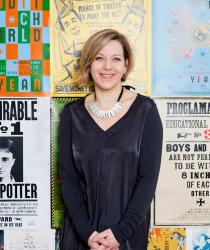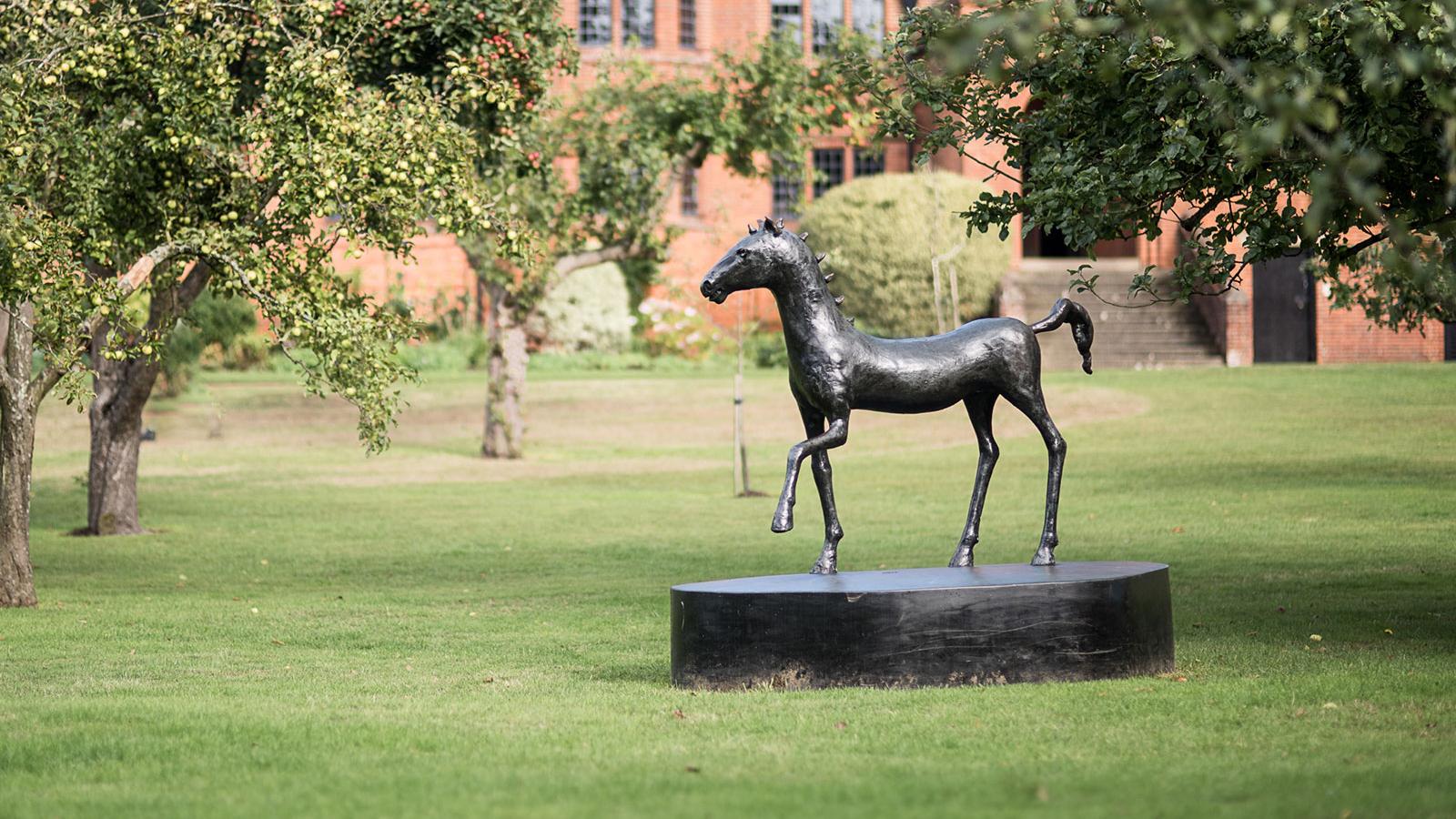
In retrospect, Bedales was an obvious destination for Miraphora Mina (always known as Mira to her Bedalian friends and acquaintances). Her father, Michael Minas, was a television designer and painter, while her mother Jacqueline was a jewellery maker, a connection that was directly responsible for Mira’s Bedales odyssey. “Mum taught jewellery at Farnham art school; she was so impressed with one particular student, whom she learned had been to Bedales,” Mira remembers. “I think that by then, she was a bit disenchanted with the lack of creative opportunity in my primary school and went straight down to Bedales to have a look at this place that seemed to encourage the arts on such a consistent basis.”
One visit was all that it took to convince the Mina family. “My parents were totally bowled over by Bedales, to such an extent that they persuaded the school to take me a year early, aged just nine!” Mira laughs. “I was really excited by the prospect as well. I was an only child but a sociable girl, who would have loved siblings in my life, and the idea of becoming a boarder seemed thrilling. I remember my first afternoon so well, running through the school fields like a lunatic, until my parents told me that they were leaving. That diluted the pleasure that I was feeling a bit but I soon settled down to a busy and creative life at school.”
As she had hoped, Bedales suited Mira to perfection. “I loved it unconditionally until probably my 6.1 year, when I started to get a bit territorial about trivial things like my possessions and stopped thinking that sharing everything was such a great idea,” she reflects. “I wasn’t sporty, which didn’t matter at all, but there was so much more to discover. I was often doing something musical, contemporary dance was something new and expressive in the 80’s, which I enjoyed a lot, and then there were the theatre productions. Acting didn’t particularly interest me but I must have done some backstage stuff for some of the school plays. My main claim to fame was directing Minnie Driver in her first stage appearance at Bedales!”
Meanwhile, Mira’s academic curriculum was featuring an inevitable predilection for the creative arts, where positive influences were not in short supply. “David Butcher, Martin Box and George Hatton were massively important people in my development,” Mira confirms. “Their early instruction had much influence on how I chose to shape my career. When my son, Luca, started at Bedales, I was immediately jerked back to the past and I realised that I still knew every corner of the place.”
David Butcher, Martin Box and George Hatton were massively important people in my development. Their early instruction had much influence on how I chose to shape my career
George Hatton’s approach to Mira’s development was perhaps a more challenging one to his budding star of a pupil. “He was rather intolerant of mediocrity, which was exactly as it should be,” Mira suggests. “In the arts, you have to work hard to make your career mark and there was never going to be any other career for me, no sort of plan B. George did challenge you all the time – I remember being slightly obsessed with Rotring pens and George encouraging me to be open minded with processes and not to be dictated to by a particular tool (many years later Mira had to design and make the ‘Marauder’s Map’ for the Harry Potter films, drawn with the same pen that George had encouraged). George also introduced me to print-making – how often would you get to do something like that at school?”
Unsure, therefore, about precisely which art form would give her the best opportunity to excel, Mira’s first year after leaving Bedales was spent on a one-year art foundation course at Kingston Polytechnic. “I wanted to get there immediately, so I didn’t bother with a year off, and I realised at once that my Bedales days had been spent in a singular place that amounted to a bit of a bubble,” she reflects. “I’m still surprised that I hadn’t recognised that before. I felt that it was important not to say that I’d been to public school but at the same time, the confidence that I had to follow an independent path had undoubtedly been ingrained at Bedales.”
From Kingston, it was off to Central Saint Martins and a theatre design qualification before Mira applied and, slightly to her own surprise, was accepted by the National Film & Television School (NFTS) to study film design. One member of the interviewing panel that ultimately gave Mira the green light would go on to play a major role in her future career. “Stuart Craig was already a successful production designer and in the interview he asked me whether I had any idea what a major art department on a film was like,” Mira recalls. “I didn’t, of course, and Stuart enlightened me, showed an interest in my future and became a kind of mentor.”
In Mira’s first year at NFTS, design work was in fact conspicuous by its absence: “We were all thrown into making documentaries and all aspects of the creative process. It’s such a team world, one in which you need some idea of how everybody else goes about playing their part in the final product. I loved working in a group, often volunteered to work on films for other people and suddenly, it all began to click for me. What I was doing seemed to be a natural progression and once again my grounding at Bedales, this time in music and dance, became so relevant.”
Mira was to leave the NFTS a year early, prompted by a job offer from one of her tutors. “I slightly regretted the fact that my experimental phase had come to an end but I was keen to start working properly, even if my job as a junior in the art department of a production designer meant starting right at the bottom of the ladder,” she says.
The confidence that I had to follow an independent path had undoubtedly been ingrained at Bedales.”
As her experience grew, Mira’s list of film credits increased exponentially, with her early work in the art department and eventually as a graphic prop designer including Circle of Friends, The Avengers, Notting Hill and Captain Corelli’s Mandolin. It was in the year 2000, however, that her professional life would change for ever with a call from her old mentor Stuart Craig. “Luca was a year old at the time and I was completely out of the loop of the cultural zeitgeist when Stuart phoned. I hadn’t read any of the Harry Potter books and the offer from Stuart to work on the first of the films was at that stage just another film. And he suggested perhaps a four month stint to start with… ”
Not quite. The series of films that followed would absorb Mira for a good deal longer and would lead to her serendipitous introduction to fellow graphic designer Eduardo Lima, whom she met in 2002. Together, Mira and Eduardo would establish the graphic design aesthetic for the entire franchise, from collectable merchandise to collaboration on the Warner Brothers studio tour, and claim responsibility for iconic artwork such as the Marauders’ Map and the spectacular Wizarding World of Harry Potter, Diagon Alley.
“The Potter stories needed a number of visual prompts and I have to say that we were given a wonderfully free rein in nurturing this new world,” Mira says. “JK Rowling herself stayed at arms’ length, only getting involved if we specifically required more background story information. Eduardo and I particularly loved the humour in her books and humour is something that has always underpinned the way in which we both work. What has been so gratifying over the years is the number of people who have told us that our designs reflect the way in which they had imagined JK Rowling’s world.”
Over nine years of working together, Mira and Eduardo Lima gradually put together the backbone of an idea for their own company. MinaLima Design was duly formed in 2010 in Goodge Street, London and, via an agreement with Warner Brothers, was licensed to produce limited edition copies of the designs that had been so successfully showcased in the eight films that comprise the Potter franchise. Not long afterwards, MinaLima, in partnership with OB Harriet Logan, set up Woop Studios as a means to gain creative ownership of their own work, a venture that gained a British Design Award nomination in 2011.
“The truth is that since we stopped working on the Potter films, most of what we’ve done has involved Harry Potter in one form or another (MinaLima now also has an eye-poppingly impressive shop on Greek Street in the heart of Soho that sells their Potter & Fantastic Beasts-related graphic art).” I did wonder whether that might be restrictive but everything has been so different and interesting. Right now, it’s the Fantastic Beasts and Where To Find Them series of films and I don’t think we’ve ever been busier.”
Mira still sounds a lot like the Bedalian that she once was. “I am in many ways and I can hardly believe that I’m nearly 50 with 20 year-old assistants working with me,” she says. “Things move so quickly but I still feel close to the person that I was then. At school, I was quite a naughty girl at times, specialising in creative misdemeanours such as painting murals in the middle of the night in places that I shouldn’t have; I’m therefore half-proud and half-alarmed that Luca has become Head Boy at Bedales! I’m entirely delighted that he has embraced the place as much as I did. The Bedales connection with my school friends is still so strong and those boarding friendships are particularly formative ones.”
There are still plenty of ambitions left that Mira would like to achieve. “I’d like to design a successful new type face and I’d absolutely love to learn to play a musical instrument really well,” she says. “The problem is that there’s just so little time. I keep thinking that at work we’ll calm down a bit at some stage but it never seems to happen. I really can’t complain, though – I’m so content as a part of this team, much more so than I would ever have been if I’d remained an individual freelancer all my life.”
Mira Mina was interviewed by James Fairweather in November 2016.

